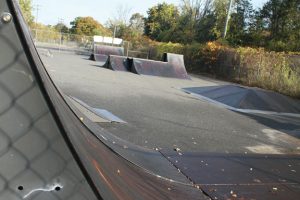
NAUGATUCK — The metal ramps at the Linden Park skatepark are dented and covered in graffiti. Not only are they outdated — they’re unsafe, according to Parks Commission Chairwoman Linda Ramos.
That’s why she’s raising money to replace the skatepark with a new concrete ramps, pipes and equipment.
With her fifth paint party at Brushstrokes on Church Street last Friday, which included wine tasting and painting for 40 guests, Ramos has raised the $10,000 she needs to apply for a grant from the Tony Hawk Foundation.
Ramos said she raised $2,735 from the paint parties, $3,500 from Walmart, and $1,100 from the Corner Tavern as well as donations from private individuals.
Parks Director Kim Eyre said modern skateparks are made from concrete, which are better for bicycles.
“The kids in Naugatuck tend to use the stairs and curbs and benches — all the things you would tend to find in a concrete skate park,” Eyre said.
The skatepark was built in 2002 with a $70,000 state grant as part of a $1 million project to upgrade Linden Park.
Eyre said she’s heard quotes of $100,000 to build a new skatepark, but she believes the borough can get one built for less, especially if it starts out with a smaller number of elements. Eyre said it will probably remain at Linden Park.
The Tony Hawk Foundation awards grants up to $25,000 for low-income areas with a high population of at-risk youth.
“While we realize that not every community can afford to build big, expensive skateparks, we feel strongly that public skateparks should be designed and constructed by experienced contractors. We also believe that local officials should treat public skateparks the same way they treat public basketball courts or tennis courts, meaning that anyone may show up and use them anytime, unsupervised,” the foundation wrote on its website.
The foundation considers skatepark projects that include local skaters in the planning, fundraising and design process and can demonstrate a strong grassroots commitment to the project. The park must have a creative mix of street obstacles and transition terrain. Parks that receive the grant must be open to the public every day of the year during daylight hours and cannot charge an entrance fee.
Between 2003 and 2009, the skatepark was plagued by vandalism, but more recently Eyre said most of the damage is done by skateboarders moving the metal pieces around into new configurations they weren’t designed to be in.
When the Linden Park skatepark was built in 2002, skaters had to register for membership through the YMCA, with a seasonal fee of $60 for residents. In a public-private partnership, the YMCA staffed the park with skate guards and safety gear was donated for skaters who didn’t own their own.
In 2003, a professional team of skateboarders from New York City hosted a special demonstration at the park to attract more members. The park sold 22 season passes that year, at a fee of $40, and the park was open from April to October.
In 2004, the borough lowered the usage fee to $1 a day or $20 a season. Hours were restricted to between 4 and 8 p.m. That summer, the YMCA ran out of money to pay for a park supervisor and turned it over the borough. That year, the locks on the park’s fence were broken over 40 times, the Republican-American reported.
In September 2005, the borough closed the park early for the season after officials said it had become a magnet for booze-drinking, foul-mouthed, destructive young people, many of whom spent more time dismantling and spray-painting ramps and half-pipes than skating on them, the Republican-American reported.
In 2006, a small group of adults pledged to monitor the park and in 2007, skateboarders began to take responsibility for the park’s condition and clean up the trash.
Since then, there have been relatively few problems with vandalism and trash at the park, which is no longer supervised.
Eyre hopes skateboarders will continue self-policing use of a new park. She said it should be easier to repair and replace parts with concrete. The company that made the metal elements no longer makes replacement parts for them, Eyre said.
On any given day after school, Eyre said it’s common to see a dozen children using the skate park.
“It’s so popular we can’t take it away and not replace it with something else,” she said.













